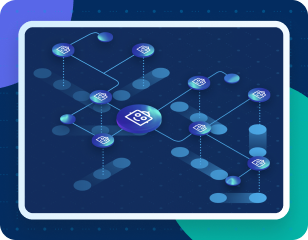In our recent whitepaper, From Digital to Agentic Transformation, we made the case that a composable architecture isn’t just a tech strategy, it’s the scaffolding that lets organizations deliver automation, agility and adaptability at scale.
But here’s the thing: composability was never going to be the endgame; it was the “unlock” for a time and place when digital transformation was the priority.
Now, it’s a different time and a different place.
We’ve entered the agentic era where AI doesn’t just assist – it initiates. AI agents aren’t just calling APIs: they’re planning, deciding, adapting, and acting. The promise of agentic transformation lies in our ability to apply new agentic architectural patterns to the composable foundations we’ve already built.
New architecture patterns are emerging
We’ve all spent time with the classic patterns such as API layering, process composition, reusable building blocks, and the mechanics that support those patterns such as scatter-gather, choice routers, pub/sub. And they still matter because digital transformation still matters.
But alongside that foundation, agents introduce a new design space: one where systems need to support autonomous reasoning, real-time decision-making and dynamic execution. These aren’t minor tweaks – they’re structural shifts.
The patterns we’ll discuss are grounded in emerging behaviors we’re already seeing in open agent frameworks, orchestration toolkits, and academic research. But to move AI out of the experimentation phase and into the enterprise at scale, we also need rigor, structure, and trust.
What follows are five patterns we see as essential in making that shift along with some of the technical foundations needed to support both composable and agentic architectures.
1. Understand: Intent routing
From logic trees to semantic resolution
The goal isn’t to route traffic anymore; the goal is to help agents route intent, with clarity, trust, and purpose. Open agent frameworks such as LangChain and AutoGPT replace static logic with semantic resolution, where agents match prompts to the right functions using embeddings, metadata and similarity scoring. Vector search over function descriptions has become a go-to strategy in these open frameworks and works well in flexible, loosely governed environments. But in the enterprise, intent needs structure.
Instead of guessing, agents resolve intent within trusted, auditable boundaries, not just based on probability, but in accordance with enterprise policy. Whether building agents or connecting them to systems, execution frameworks that chain LLM calls with function selectors and control logic, paired with policy-enforced gateways, bring structure to an otherwise probabilistic process. The result: function selection that is increasingly deterministic, governed, and aligned with the composable integration layer.
But selecting the right function is only part of the equation. Enterprise-grade intent routing must also explain why a function was chosen, fail gracefully under ambiguity, and integrate with governance and observability systems. Policy enforcement and AI governance ensure sensitive functions are only invoked by authorized agents, with every decision logged, explainable, and aligned to enterprise controls.
Think of intent routing as the moment an agent decides what it needs to do, i.e. “I need to check my order status”. That decision is the outcome of resolving intent. But knowing what to do is just the beginning. Once intent is resolved, agents need a safe way to plan for how to do it: which tools to use, in what order, and how to adapt if things change. That’s where cognitive orchestration takes over.
2. Plan: Cognitive orchestration
From predefined flows to real-time reasoning
Cognitive orchestration is the reasoning process that follows intent routing. Where intent routing is about selecting the right function, cognitive orchestration is about sequencing, planning how to achieve that intent.
Imagine the intent is (routed) to resolve a support case: an agent might reason by checking history, reviewing orders, consulting knowledge and escalating or processing a refund. Each step touches sensitive systems and policies.
Frameworks like ReAct, AutoGPT, and LangGraph popularize agentic reasoning through reflection, memory, and iterative planning. Instead of following a fixed flow, agents experiment, observe outcomes, and adapt. This flexibility is powerful, but in enterprise environments, it must be paired with safeguards for safety, explainability, and interoperability.
Enterprise-grade agentic reasoning requires structured planning engines that apply policy guardrails and generate reusable, auditable traces. These traces support compliance, allow cross-workflow reuse, and ensure reasoning is transparent and policy-aligned.
Cognitive orchestration isn’t limited to a single agent. As registries and meshes emerge, agents must collaborate securely, requiring scoped identity, persistent memory, encrypted channels, and shared policies. Frameworks like Agent-to-Agent (A2A) and policy-enforced gateways provide the backbone for this kind of distributed, governed reasoning.
This isn’t about locking agents down, it’s about giving them space to reason with structure, observability, and control. Every decision, every function it calls, every handoff is captured in context. And because it’s interoperating across systems with shared governance, it becomes part of something far more powerful than a smart script: an intelligent, collaborative ecosystem.
3. Context: Federated context graphs
From enrichment to situational awareness
For agents to act meaningfully, they need rich, recent, relevant context, like who the user is, what’s happened recently, which systems or objects are involved and what it or other agents’ prior actions have already been. That’s more than just data, that’s context. And in most enterprises, that context is scattered across APIs, databases, logs, conversations, events and memory stores.
A federated context graph is a way to bring that fragmented context together into a unified, queryable model. It’s not just integration, it’s a rethinking of how enterprise knowledge is modeled. Instead of treating enterprise systems as isolated silos, the graph forms a semantic, connected model that agents can access and reason over in real time.
Federated by design, this approach extends your current systems by layering a contextual model across existing APIs and data flows. As data moves through the enterprise, enriching it with semantic metadata, tagging relationships, and assigning meaning transforms it into usable context for agents, especially when passed through vector-aware connectors into a live, queryable graph abstraction. Integration-layer access policies ensure that this context is governed end-to-end, with agents only able to query what they’re authorized to see.
Now, that graph becomes something an agent can actually use. It transforms from static databases to a living model of the enterprise. The agent can ask questions like:
- “Has anyone else responded to this customer?”
- “What recent events might explain this system behavior?”
- “What team owns this part of the process?”
This continuity of awareness makes every action more intelligent. Without this kind of shared awareness, agents risk repeating actions or acting blindly. With a federated context graph in place, agents don’t just act, they understand and coordinate.
4. Execute: Composable agent actions and trust-aware execution
From APIs as endpoints to APIs as discoverable actions
Open AI ecosystems like LangChain, Hugging Face Agents, and OpenAI’s function calling let agents dynamically discover and invoke functionality. The pattern is clear: APIs aren’t just endpoints anymore, they’re actions.
Modern agent-focused design platforms such as Cursor and Windsurf are not just a UX enhancement on an old development methodology; they are a foundational capability that can help teams describe, implement and deploy APIs in natural language with semantic metadata, making them directly usable by agents. Because APIs need to be well-described, governed, versioned, and testable, they need to carry I/O contracts and semantic meaning, i.e. what they do and when they should be used.
Designing APIs that are usable by agents is only half the story. Once an agent can discover and understand an action, it also needs to invoke it responsibly. In enterprise environments, that means every action must be authorized, explainable, and traceable – not just accessible.
Trust-aware execution frameworks make this possible by ensuring agents carry identity, context, and intent when performing actions. Protocols like Model Context Protocol (MCP) formalize this pattern, supporting real-time delegation, scoped authority, and policy-aware control. Paired with secure API mediation and agent orchestration frameworks, these tools turn agent actions into governed, auditable events.
As these capabilities converge, agent ecosystems start to resemble a distributed mesh of intelligent services. An “internet of agents” emerges where autonomous agents are securely registered, discovered, and delegated responsibility based on policy and context. For example, agent-to-agent (A2A) and governance layers provide the trust fabric that makes this coordination possible, enabling agents not just to act independently, but to collaborate safely across systems.
The result is a shift from APIs built for developers to APIs that are discoverable, composable, and safe for autonomous agents to use at runtime.
5. Evolve: Reflective retry and self-healing
From static retries to adaptive recovery
Reflective retry builds on patterns from reinforcement learning where the goal isn’t just to try again, it’s to recover intelligently. In agent systems, the hard part isn’t the retry itself; rather, it’s adapting based on what went wrong. In enterprise environments, retry logic must be observable, tunable, and auditable, especially when agent decisions affect customers, revenue, or critical operations. That behavior can’t happen in the dark.
In orchestrated environments, self-healing goes beyond a single agent. The agentic execution layer must coordinate with multiple agents’ reasoning engines, enabling shared awareness and system-wide adaptation. For example, if a delegated agent encounters a task beyond its capabilities, it can escalate or defer to a more capable agent rather than fail outright.
The integration layer often powers the execution tier by handling adaptive retries across APIs, emitting real-time signals to agents, and enriching logs for downstream analysis. This feedback does not just inform one agent; it becomes a shared signal across the system. The result is a collective learning loop, where agents do not just recover independently, they evolve together through a common feedback backbone.
This isn’t just resilience – it’s autonomy. Over time, retries shape strategy, failures improve prompts, and planning loops evolve. Reflective retry becomes a foundation for agents that don’t just persist, but grow, learning to act more effectively, responsibly, and independently.
And as agents adapt, those changes must happen inside secure boundaries. Governance frameworks ensure retries remain auditable, policy-compliant, and within safe limits. Whether the agent is native to the integration platform or orchestrated through it, it enables a shift from error handling to intelligent, accountable adaptation.
Emerging trends and future considerations
The patterns we’ve explored may feel new, but they’re already grounded in real-world applications emerging across agent frameworks, orchestration toolkits, and evolving enterprise architectures.
What’s changing isn’t how we build – it’s who we’re building for. These new patterns aren’t just for developers anymore, they’re for agents.
The true promise of the agentic era isn’t just faster automation. It’s about systems that act with context, adapt with insight, and improve with every decision. When applied thoughtfully, these patterns don’t just enable agentic systems, but they also ensure the systems operate ethically, securely, and purposefully.
As these patterns mature, one of the most important design considerations will be balancing autonomy with oversight. In low-risk, high-volume scenarios, full autonomy may be perfectly appropriate, even essential to achieving scale. But in sensitive or regulated workflows, agent actions may require safeguards like escalation paths, approvals, or human-in-the-loop checkpoints.
Agentic systems don’t replace human judgment, they augment it with built-in guardrails that ensure every autonomous decision is traceable, explainable, and aligned with enterprise policy.If you’ve built with composability in mind, you’re already ahead. Applying these patterns takes that composability from passive potential to something aware, powerful, and action-oriented.









